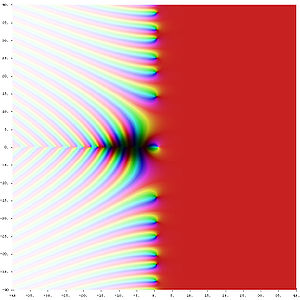Riemann zeta function
The English used in this article or section may not be easy for everybody to understand. (February 2018) |
In mathematics, the Riemann zeta function is an important function in number theory. It is related to the distribution of prime numbers. It also has uses in other areas such as physics, probability theory, and applied statistics. It is named after the German mathematician Bernhard Riemann, who wrote about it in the memoir "On the Number of Primes Less Than a Given Quantity", published in 1859.


The Riemann hypothesis is a conjecture about the distribution of the zeros of the Riemann zeta function. Many mathematicians consider the Riemann hypothesis to be the most important unsolved problem in pure mathematics. [1] In the year 2000, the Clay Mathematics Institute included the Riemann hypothesis as one of their Millennium Prize Problems, promising a reward of US$1 million to anyone who could solve it.
Definition
changeWhen using mathematical symbols to describe the Riemann zeta function, it is represented as an analytic continuation of infinite series:[2]
where is the real part of the complex number . For example, if , then (where ).
This makes a sequence. The first few terms of this sequence would be,[3]
- and so on
However, this doesn't apply for numbers where , since if we interpret this function as an infinite sum, the sum does not converge. Instead, it diverges. This means that instead of nearing a specific value, it will get infinitely large. Riemann used analytic continuation, so that he could give a value to all numbers except 1. does not have a limit in that point and thus the function is not defined there.
Leonhard Euler discovered the first results about the series that this function represents in the eighteenth century. He proved that the Zeta function can be written as an infinite product of prime numbers. In mathematical notation:
This is an infinite product. means that only prime numbers are included in the product. The first few terms of the product would look like:
Zeros, the critical line, and the Riemann hypothesis
changeMathematicians are interested in those values of for which the function is equal to zero. The Riemann hypothesis conjectures that all the "non-trivial zeros" lie on the critical line , meaning they are guessed to be of the form for some real value t.[4] It is already known that all of the non-trivial zeroes must lie in a region called the "critical strip" for which . So far, all of the computed nontrivial zeros are on the critical line.
Proving or disproving the hypothesis has been very difficult, and is still troubling mathematicians to this day.
Proof of the Euler product formula for the Riemann zeta function
changeRepeating for the next term:
Subtracting again we get:
where all elements having a factor of 3 or 2 (or both) are removed.
It can be seen that the right side is being sieved. Repeating infinitely for where is prime, we get:
Dividing both sides by everything but the ζ(s) we obtain:
Related pages
changeReferences
change- ↑ Riemann, Bernhard. "On the Number of Prime Numbers less than a Given Quantity" (PDF). Archived from the original (PDF) on 2016-03-04. Retrieved 2016-03-09.
- ↑ "List of Calculus and Analysis Symbols". Math Vault. 2020-05-11. Retrieved 2020-10-06.
- ↑ "Riemann zeta function | mathematics". Encyclopedia Britannica. Retrieved 2020-10-06.
- ↑ Weisstein, Eric W. "Riemann Zeta Function". mathworld.wolfram.com. Retrieved 2020-10-06.